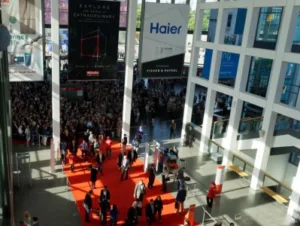We’ve got to the end of another IFA. The show was interesting but is not as interesting from a technology point of view as CES – and there’s a reason for this. Because of the timing, IFA is the place where a lot of retailers and consumers decide what to buy – the organisers estimate orders for more than 4 billlion Euros are placed by resellers at the show. As a consequence, vendors and brands are reluctant to show anything that might undermine the purchasing decisions. By CES, the buyers are thinking about the next year’s product range, so there are more new products.
OLED TV was, without question, the big topic which was endorsed by every TV brand except Samsung and Sharp (and local vendor, Technisat). The OLED TVs are at the high end and will be limited by the supply situation, but there seems to be little question that OLED has captured the minds of brands and many consumers as the displays of choice for image quality. Samsung is reported to be struggling in market segments where it competes with OLED, so we expect to see some reaction from Samsung. There are special promotions in the market, but perhaps there will be something dramatic at CES!
Microsoft made some noise about its ‘mixed reality’ headsets, due from five partners (see the round up in this report) in the middle of October. On all the demos that I have seen, the experience has been of Virtual Reality without real mapping of the actual environment into the headset. The headsets feel more comfortable than others and the hand controllers seem both well designed and effective in being tracked by the headsets. They should sell well, although I doubt I will buy a set as I hate the pixellation!
 IFA 2017 was busy. Image:Meko
IFA 2017 was busy. Image:Meko
There were plenty of gaming monitors at the show and it seemed to me that the PC industry is being re-invigorated by the development of PC gaming. Our good friend, Dr Jon Peddie, has pointed out the huge advantages in the gaming industry now that the PlayStation and the XBox are built on an X86 platform, which means both a common code base, and release for developers from the development difficulties of the previous PlayStation platform. The PC vendors are exploiting this again.
We expected to hear more about HDR and, specifically, HDR10+, but it may have been a bit early for companies to react to the announcement by Samsung and Panasonic. However, it looks as though HDR10+ is going to be widely adopted as it has the advantages of Dolby Vision, but based on an open platform. We’re meeting Dolby in the next few days at IBC and we expect strong messaging to highlight advantages of Dolby Vision compared to HDR10+. There was almost no discussion of HFR, as the broadcast industry, which is interested in this technology, is several years away from really trying to make it practical. That’s a shame, but understandable.
We spoke to the HDMI Licensing group about HDR10+ in the interface, but the group said ‘it’s just data’ so can be transmitted across HDMI 2.1. It’s not clear to me that there will be a solution for earlier versions of HDMI, but the group will look at the issue. Of course, it’s in the nature of HDMI to allow many options, but mandate few, so confusion will, no doubt, reign for a year or two.
LG launched the V30 phone, but otherwise there were few new smartphones at the show and what there were were mostly mid-range. As a result, LG said that it had won 26 awards at the show for the V30! It looks like a good phone and should help to boost LG’s presence in the smartphone market.
The main news in wearables was from Samsung although brands such as MyKronoz and Garmin are developing well, based on the idea of hybrid devices. Of course, the Apple announcements expected on the new iPhone and Apple Watch hanging over the show. Of course, Apple doesn’t attend IFA.
Finally, we saw some great projectors from Epson, JVC, Sony, Optoma and LG. There were some good demos although the contrast of OLED is detracting from the ‘Wow’ factor that we used to experience when we saw products such as the high end Sony and JVC units.

